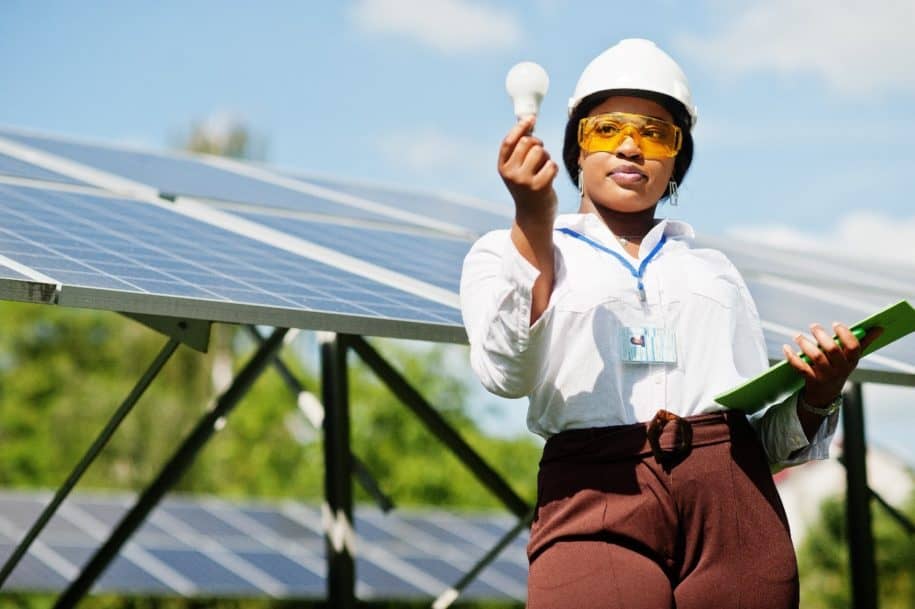Rapid industrialization brings with it a heightened thirst for electricity. With the growing reliance on phones, computers, and cars for daily activities, barely anyone is spared from electric consumption. Unfortunately, with great power demand comes great responsibility. With the world annually burning terawatt-hours of fossil fuels, CO2 emissions are also drastically increasing, accelerating climate change. To encourage sustainable business practices, investors are now focusing on efforts to reduce carbon emissions. To ease the acceptance of the changes resulting from this shift in priorities, the following is a deep dive into some of the world’s top renewable energy alternatives.
SOLAR POWER
How it Works
In theory, solar power could satisfy the world’s energy demand for an entire year after just 1.5 hours of illumination. Regarding practicality, building an efficient light-collecting infrastructure remains a monumental problem. There are two predominant ways of harnessing solar energy:
- Solar thermal energy concentrates light energy using mirrors to heat a fluid and produce steam. The steam subsequently turns turbines connected to a generator, producing electricity.
- Photovoltaic (PV) technologies make use of sophisticated materials called photovoltaic cells, directly converting solar energy to electricity. These cells are made of semiconductor materials that, when illuminated by sunlight, create moving electrical charges or electricity.
Current Status
Solar photovoltaic energy is a fast-growing renewable energy resource, accounting for 3.1% of the world’s total electricity generation in 2019. In 2020, driven by declining costs and government incentives, solar photovoltaic grew by 45% in the U.S. market. Due to increases in the light-harvesting efficiency of the most advanced photovoltaic cells, solar energy is becoming the most cost-effective electricity source in most of the world, cheaper than coal and gas. The promotion of solar power by government and commercial agencies is projected to cause an increase in its share of total electricity generation, from 3% in 2019 to 20% in 2050.
WIND
How it Works
Wind turbines collect kinetic energy from the wind and convert it into electricity. Most wind turbines use three blades mounted on a 100-ft tower to capitalize on the faster wind speeds at higher altitudes. The blades are designed to generate lift, which then turns it along with the driveshaft. The turning drive shaft is connected to the generator, which converts mechanical energy to electricity.
Current Status
Wind is the second biggest source of renewable energy in the world, generating more than 6% of the total electricity consumed in 2020. Recent years have seen an unprecedented increase in global wind electricity generation, largely due to investment pushes from the U.S. and China. The U.S. government recognizes wind energy as a pillar in achieving long-term clean energy generation objectives and the goal of 100% clean electricity by 2035. The U.S. Department of Energy published an assessment of the national wind power supply chain, highlighting the challenges and promises of wind power generation. In 2020, wind supplied 8.3% of the electricity generated across the United States, 10% in 16 states, and over 30% in Iowa, Kansas, North Dakota, Oklahoma, and South Dakota.
HYDROELECTRIC POWER
How it works
Hydroelectric power generation taps the energy of water currents, producing electricity with little to no accompanying greenhouse gas emissions. Water flowing in rivers or stored in reservoirs is made to pass through an intake structure (such as a pipe) inside of a dam, turning the blade of a turbine. As with the mechanisms in wind turbines, the rotating motion within the generator converts the energy into electricity.
Current status
Hydropower comprises the majority of energy coming from renewables worldwide, surpassing contributions from solar photovoltaic, wind, geothermal, and biomass combined. The U.S. Department of Energy considers hydropower as an extremely reliable resource. As such, from 2010 to 2019, the government contributed 8 billion USD to refurbishments and upgrades to national hydropower facilities. In 2020, hydropower accounted for 37% of electricity from renewable sources (7.3% of the United States’ total generated electricity).
What’s Stopping the World from Going Green?
With every gain comes some loss. While investment increases have given renewable energy sources a lift in the past decade, green energy still has a long way to go. Solar and wind energies are highly dependent on weather phenomena, diminishing their reliability. Large-scale solar farms need massive square footage to collect sunlight, which can displace agricultural production or other types of land use. Hydroelectric power also requires the construction of dams and other infrastructures which alters the ecology of an area, decreasing biodiversity. Meanwhile, moving turbines create large amounts of noise pollution, affecting nearby communities. Additionally, studies are recording the issue of birds colliding with the moving turbines. This can displace migratory patterns of birds and the overall ecosystem of the wind farm’s location.
Even with the disadvantages inherent to renewable energy technologies, the devastating impacts of climate change have served as a siren to alert the world of the need to put an end to fossil fuel use. While it will take years of smart and cautious planning to completely transition to a green economy based on renewable energy sources, current efforts from government and private enterprises are promising the reality of this future.
Author Bio
The SafetyStratus Research Advisory Group (RAG) brings together thought leaders from the global environmental, health, and safety community to promote best practices and provide key insights in the profession and the industries they serve. The Research Advisory Group also advocates, where practical, the intersection of and advances with the use of technology, such as the SafetyStratus enterprise EHS software platform. Group membership consists of representatives from across varied disciplines and market sectors as well as select members of the SafetyStratus team.
The primary objectives of the SafetyStratus RAG partnership are to:
- Build a strategic partnership between EHS practitioners and the SafetyStratus team.
- Provide engaging and practical content to the global EHS community.
- Provide discipline and market feedback specific to SafetyStratus products and services.
While the objectives of the RAG are varied, the primary public-facing outcome will be available through engaging and practical content found on the SafetyStratus resource pages. Various articles, papers, and other valuable resources will be produced and shared as part of an ongoing effort to cultivate a robust community. Ultimately, the SafetyStratus RAG will expand to have a broader reach and provide opportunities for more inclusion by all interested EHS professionals in a collaborative community environment.
Sources:
Bojek, Piotr. (2022, September). Solar PV. IEA. https://www.iea.org/reports/solar-pv
Bojek, Piotr. (2022, September). Wind Electricity. IEA. https://www.iea.org/reports/wind-electricity
Carroll, M. (2023, January). Considerations for Transferring Agricultural Land to Solar Panel Energy Production. NC Cooperative Extension. https://craven.ces.ncsu.edu/considerations-for-transferring-agricultural-land-to-solar-panel-energy-production/
Center for Climate and Energy Solutions. (n.d.). Renewable Energy. https://www.c2es.org/content/renewable-energy/
EIA. (2022, November 7). Hydropower explained: Hydropower and the environment. U.S. Energy Information Administration. https://www.eia.gov/energyexplained/hydropower/hydropower-and-the-environment.php
EIA. (2022, April 15). Solar explained: Solar thermal power plants. U.S. Energy Information Administration. https://www.eia.gov/energyexplained/solar/solar-thermal-power-plants.php
EIA. (2021, November 16). Today in Energy. U.S. Energy Information Administration. https://www.eia.gov/todayinenergy/detail.php
EIA. (2022, February). Wind explained: Electricity generation from wind. U.S. Energy Information Administration. https://www.eia.gov/energyexplained/wind/electricity-generation-from-wind.php
Evans, Simon. (2020, October 13). Solar is now ‘cheapest electricity in history,’ confirms IEA. Carbon Brief. https://www.carbonbrief.org/solar-is-now-cheapest-electricity-in-history-confirms-iea
International Energy Agency. (2020). IEA Wind TCP Annual Report 2020. https://www.epaper.dk/dtupaper/rapport/iea-wind-a-rsrapport-2020/
International Energy Agency. (2021). Hydropower Special Market Report Analysis and forecast to 2030. https://iea.blob.core.windows.net/assets/4d2d4365-08c6-4171-9ea2-8549fabd1c8d/HydropowerSpecialMarketReport_corr.pdf
Marques, A., Santos, C., Hanssen, F., Muñoz, A., Onrubia, A., & Wikelski, M. (2019). Wind turbines cause functional habitat loss for migratory soaring birds. Journal Of Animal Ecology, 89(1), 93-103. DOI: 10.1111/1365-2656.12961
Solar Energy Technologies Office. (n.d.). How Does Solar Work?. Energy.gov. https://www.energy.gov/eere/solar/how-does-solar-work
The White House. (2021, April 22). FACT SHEET: President Biden Sets 2030 Greenhouse Gas Pollution Reduction Target Aimed at Creating Good-Paying Union Jobs and Securing U.S. Leadership on Clean Energy Technologies. https://www.whitehouse.gov/briefing-room/statements-releases/2021/04/22/fact-sheet-president-biden-sets-2030-greenhouse-gas-pollution-reduction-target-aimed-at-creating-good-paying-union-jobs-and-securing-u-s-leadership-on-clean-energy-technologies/
This Old House Reviews Team. (2023, April 4). Are Solar Panels Worth It?. https://www.thisoldhouse.com/solar-alternative-energy/reviews/are-solar-panels-worth-it
Uría-Martínez, R., Johnson, M. M., Shan, R., Samu, N., Oladosu, G., Werble, J., & Battey, H. (2021, January). U.S. Hydropower Market Report. US Department of Energy. https://www.energy.gov/sites/prod/files/2021/01/f82/us-hydropower-market-report-full-2021.pdf
Wiser, R., Bolinger, M., Hoen, B., Millstein, D., Rand, J., Barbose, G., Darghouth, N., Gorman, W., Jeong, S., Mills, A., & Paulos, B. (2021). Land-Based Wind Market Report: 2021 Edition. US Department of Energy. https://www.energy.gov/sites/default/files/2021-08/Land-Based%20Wind%20Market%20Report%202021%20Edition_Full%20Report_FINAL.pdf



